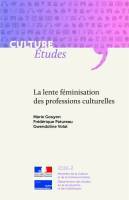Marie GOUYON, Frédérique PATUREAU, Gwendoline VOLAT
november 2016
20 p.
Since the 1960s, one of the major transformations in the professional sphere has been the increasing proportion of women in work, and the cultural professions are no exception: the proportion of women in the cultural professions has risen from 39% to 43% between 1991 and 2013. Almost all the male-dominated professions of the early 1990s, for example art, architecture and photography, have since opened up to women. Nevertheless, the proportion of women remains below the national average, where women represent 48% of all professions; this might be considered surprising when one considers the overrepresentation of women when it comes to cultural participation.
Whilst on the increase, jobs for women have broadly embraced the employment conditions prevalent in the cultural professions, such as their greater levels of flexibility: female workers in the cultural professions are, more often than female workers overall, unsalaried or working short-term contracts. They are more likely to work part-time, with variable and irregular hours, and work evenings and weekends.
Moreover, their access to the artistic and cultural professions confirms the view that women tend to be educationally overqualified: in 2013, over 50% of female workers in these professions have completed at least 3 years of higher education, as compared with their male counterparts, about 40% – an even greater level of overqualification given that these are traditionally maledominated professions.


